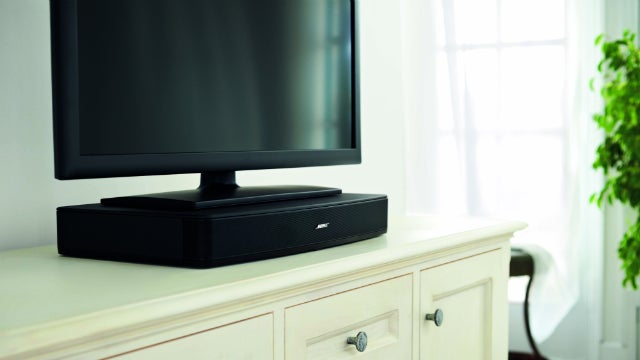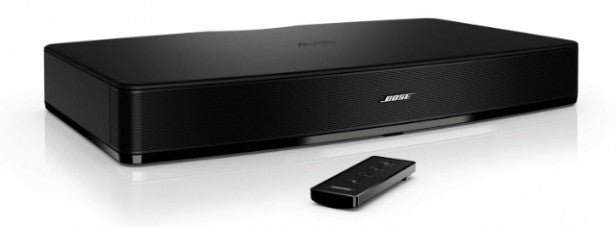Bose Solo Review
Bose Solo
Bose boosts TV sound with a simple if overpriced speaker base

Sections
- Page 1 Bose Solo Review
- Page 2 Operation, Performance and Verdict Review
Verdict
Pros
- Solid sound quality
- Easy to install and use
- Sturdy, discreet design
Cons
- Limited features for the money
- Expensive
- Optical input access
Key Specifications
- Review Price: £349.95
- Four front drivers and rear reflex ports
- Bose digital signal processing
- Optical, coaxial and analogue inputs
- Supports TVs up to 42-inch (18kg in weight)
- Supplied four-button remote
What is the Bose Solo?
Our voyage through the world of under-TV speakers continues with the Bose Solo, which looks to fend off competition from the Denon DHT-T100, Cambridge Audio Minx TV and Maxell MXSP-SB3000 in this burgeoning area of the audio systems market.
The premise of Bose Solo is simple – it’s a slim speaker box that sits under your TV and upgrades its lacklustre sound to something bigger and better, without any of the clutter that comes with a regular sound system. It was actually launched before all of the models above, and first introduced the idea of placing a TV on top of a speaker. But at £350, it’s more expensive than its rivals, so we’re hoping Bose can justify that with top-drawer sound, features and design.
SEE ALSO: 6 best soundbars you can buy
Bose Solo – Design
The Solo is a low-key but attractive unit, finished in black from top to bottom. From the sofa, all you can see is a black mesh bearing the Bose logo, with a small LED indicating power status. Build quality is excellent, although it’s not as impressive as the Denon DHT-T100, which costs some £100 less.
The 70mm-high cabinet is sturdily constructed and curves slightly at the front, which lends a touch of elegance. The sides are straight, not sloped like the Maxell and Cambridge Audio. The top panel will accommodate TV stands up to 510mm wide and 260mm deep, which easily covers 32-inch TVs and many TVs up to 42-inch. Weight-wise, it’ll support up to 18kg.
On the back are optical and coaxial digital inputs and analogue RCA input, with a couple of built-in clips to keep the cables tidy. That’s fine if you just want to connect a TV, but no good if you want to hook up all your kit and use Solo as an audio hub. You could be forgiven for expecting more for the money, perhaps HDMI sockets or a USB port for playback of MP3 files.
It’s also a little inconvenient not to find a 3.5mm input on the back for MP3 players (you have to use an RCA-to-minijack cable) and because the optical digital port is sunk into a hole, it prevented us from connecting a cable with a thick round plug. You don’t get an optical lead in the box either, so we had to nick a thin cable from the Denon DHT-T100’s box.
Bose Solo – Features
Solo’s feature list is also disappointing for the money, particularly the absence of Bluetooth, which is found on all of its rivals. The ability to stream music wirelessly from mobile devices would have been a useful, convenient feature, and exactly the sort of thing you’d expect from a £350 plinth.
There are also no sound modes or adjustments either, but we quite like the simplicity of that. There’s on-board Dolby Digital decoding, while Bose’s proprietary digital signal processing optimises the sound and keeps the volume level consistent. Bose’s speaker array technology includes four front drivers and two rear bass reflex ports.



